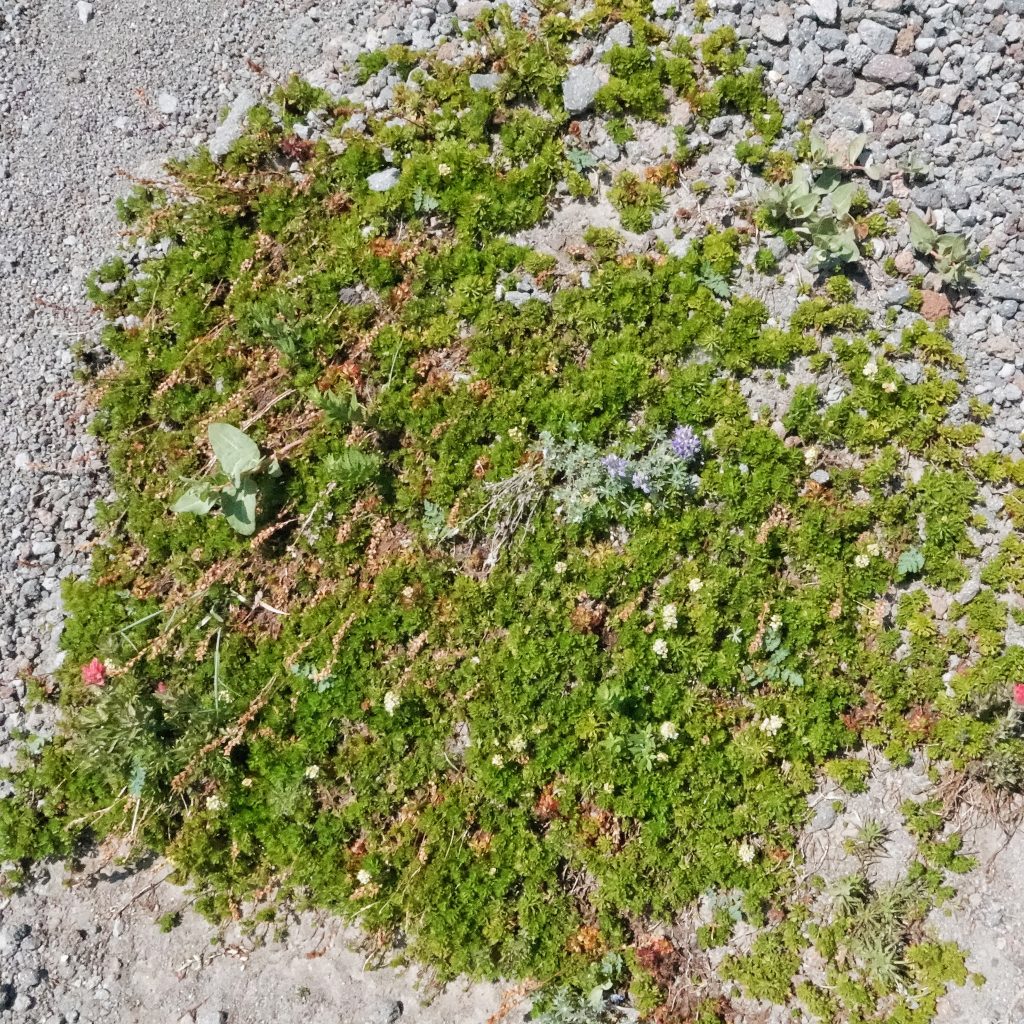
The first time I noticed this plant was last fall when I was looking for Pinus albicaulis (White-bark Pine), and I was quite struck by it being the only thing growing on the ground that was still green, and a bright green it was, especially against the background of rocky pumice sand. It didn’t have any flowers by then but the leaflets were so distinctive that I came to the conclusion it was probably partridgefoot, and the thing that inspired me to make the first of my recent trips to Mt. Hood was realizing that it was probably in bloom at that time, though I was rewarded with much more than that.

Oddly, except for an aphid that was discovered in 2002, I can find no information on what eats this pretty little member of the fmily Rosaceae. I say oddly because, like the Koenigia davisiae I recently profiled, it is one of the few things growing in some areas of very poor soil, although I saw hardly any pollinators dining at its flowers (though they may have just been active elsewhere). My guess is that some browsing mammals do eat it if they happen to be in its vicinity, but those areas where it grows are not often mammal rich. This is probably another example of a species that plays a larger role in its ecosystem than we realize, because it hasn’t been the focus of many studies.

“The leaves of Partridge-foot (Luetkea pectinata) are wedge-shaped in outline but are deeply dissected into three sets of linear leaflets that superficially resemble the three toes of a game bird. These leaves are densely crowded in a basal rosette above a short, woody rootstalk. The plant’s woody base is too short to qualify it as a shrub, but too ligneous to be an herb, so botanist’s classify it as a subshrub or semi-shrub. Individual clusters of basal leaves are connected at or below ground level by woody rhizomes and stolons, allowing the Partridge-foot to form extensive, bright green mats. Slender, leafy stems rise 4-6 inches above the basal mat and are topped by a dense, spike-like raceme of white, 5-petaled rose-like flowers.” Walter Fertig, USDA Plant of the week entry for Partridge-foot

Ethnobotany– “…Decoction of plant taken for profuse or prolonged menstruation…Decoction of plant taken for abdominal pains…Poultice of crushed, fresh plant applied to sores…” For more information see the 11 entries for this plant at BRIT – Native American Ethnobotany Database

Description-Perennial; Less than 6” tall “Mats with rooting runners creating new plants, thick with evergreen leaves, upright stems. Leaves 1/2 in., divided into sharply pointed linear segments. Upright stems leafy, tall, straight, with white flowers in dense spikes. Flowers small, 5 white petals, approximately 20 obvious stamens.” Luetkea pectinata | Partridgefoot | Wildflowers of the Pacific Northwest
Similar species– There is really nothing else in our region that looks like partridgefoot when it’s in bloom, but it could be confused with some Lomatium before it flowers, though they don’t have evergreen leaflets.

Habitat– “Luetkea Pectinata (Residual or Regosolic Phase) Community. This phase of the Luetkea community occurs on moist, relatively poorly drained slopes and flat areas. It reaches its best development adjacent to the Carex nigricans community type. Surface water usually does not accumulate on sites occupied by the Luet- kea community and the snow-free season is from 1 to 4 weeks longer than that of the Carex nigricans community…Luetkea Pectinata (Rawmark Phase) Com- munity. Northerly, fairly well drained, steep to moderate slopes are the typical site of this phase of the Luetkea community type in the western North Cascades. The short snow-free season is from 2 to 4 weeks longer than that of the Saxifraga community type…Rawmark soils are poorly developed because of soil movement and were first described in Europe by Kubiena (1953). On northerly aspects in the study area these soils are often associated with recent glacial moraines. The habitat is characterized by short snow-free periods, moist soils, and the lack of a closed vegetative cover.” George Douglas; 1972 https://www.tandfonline.com/doi/pdf/10.1080/00040851.1972.12003635; Also found “on sandy soil in moist or shady places, subalpine to alpine” Luetkea pectinata – Burke Herbarium Image Collection in “moist meadows, conifer forests, subalpine and alpine, often where snow persists” Luetkea pectinata | Partridgefoot | Wildflowers of the Pacific Northwest

Range– “It is endemic to the cold portions of western North America occurring in subarctic Alaska, Yukon, western Northwest Territories, and subalpine to alpine regions of British Columbia, southwestern Alberta, Washington, Oregon, Idaho, northern California and western Montana.” Partridgefoot – Visit Rainier; in our region it is found primarily in the Cascades, Siskiyous, and Olympics.

Eaten by– The aphid Ericaphis louisae; I can find no other information on what may eat this plant.
Reproductive timing– Flowers bloom June into August.
Etymology of names– Luetkea “commemorates Count Luetke, a Russian captain and explorer of the early 1800s who mapped the coastline of Alaska.” https://en.wikipedia.org/wiki/Luetkea . The specific epithet pectinata appears to be from the Latin word for comb, and probably refers to the deeply dissected leaflets.

Luetkea pectinata | Partridgefoot | Wildflowers of the Pacific Northwest
Partridgefoot • Luetkea pectinata – Biodiversity of the Central Coast
https://www.tandfonline.com/doi/pdf/10.1080/00040851.1972.12003635
BRIT – Native American Ethnobotany Database
subalpine – A Wildflower Journal

Keep them coming, Dan! I for one really appreciate having these one-stop write-ups.
Thanks for you appreciation, Trevor!
I am looking to purchase Partridge Foot (Luetkea pectinata) seeds. Do you know of any place that sells them please? I have tried a few sites, but have not had any luck yet.
Sorry, Mary, I don’t have a clue, but I’ll bet they would be beautiful in a garden. Good luck!